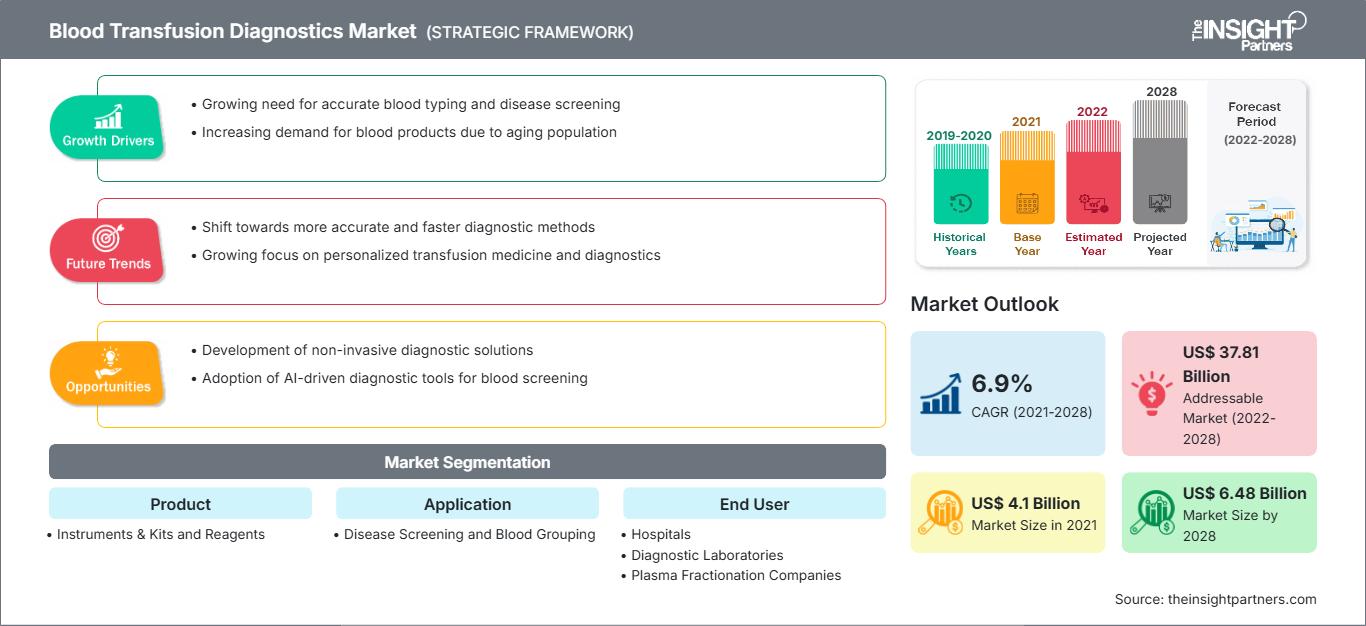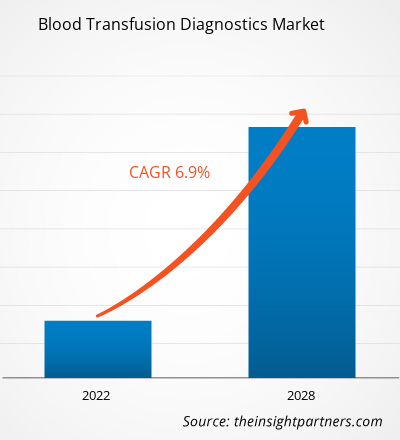[Rapporto di ricerca]Si prevede che il mercato della diagnostica trasfusionale passerà da 4.096,93 milioni di dollari nel 2021 a 6.483,75 milioni di dollari entro il 2028. Si stima una crescita a un CAGR del 6,9% dal 2022 al 2028.
La diagnostica trasfusionale è un esame eseguito sul sangue prima della sua trasfusione ai pazienti. Una trasfusione di sangue è una procedura comune in cui il sangue donato o i suoi componenti vengono trasfusi nel corpo del paziente attraverso una via di somministrazione endovenosa. Ogni unità di sangue deve essere sottoposta a tipizzazione sanguigna, ovvero all'identificazione del gruppo sanguigno e allo screening del sangue, inclusi test di rilevamento delle malattie per evitare effetti collaterali o trasmissione di infezioni.
Il rapporto offre approfondimenti e analisi approfondite del mercato globale della diagnostica trasfusionale, evidenziando diversi parametri, tra cui tendenze di mercato, progressi tecnologici, dinamiche di mercato e analisi del panorama competitivo dei principali operatori globali. Include anche l'impatto della pandemia di COVID-19 sul mercato in tutte le regioni. La pandemia di COVID-19 ha avuto un impatto negativo sulla crescita del mercato globale della diagnostica trasfusionale. Ha evidenziato un forte calo dei ricavi a causa delle severe restrizioni imposte dal governo, con conseguente riduzione del numero di interventi chirurgici eseguiti. Questi servizi sono utilizzati principalmente in interventi chirurgici con elevate perdite di sangue, come quelli ortopedici e cardiaci. A causa della diminuzione del numero di interventi chirurgici eseguiti, la domanda di trasfusioni di sangue è diminuita. Ad esempio: secondo i dati pubblicati dall'American Medical Association, si stima che negli Stati Uniti si sia verificata una riduzione del 48% del totale degli interventi chirurgici eseguiti a causa della pandemia di COVID-19. Tuttavia, dopo che le restrizioni dovute alla pandemia si sono normalizzate, il volume degli interventi chirurgici è tornato a livelli normali.
Personalizza questo rapporto in base alle tue esigenze
Potrai personalizzare gratuitamente qualsiasi rapporto, comprese parti di questo rapporto, o analisi a livello di paese, pacchetto dati Excel, oltre a usufruire di grandi offerte e sconti per start-up e università
Mercato della diagnostica delle trasfusioni di sangue: Approfondimenti strategici

- Ottieni le principali tendenze chiave del mercato di questo rapporto.Questo campione GRATUITO includerà l'analisi dei dati, che vanno dalle tendenze di mercato alle stime e alle previsioni.
Potrai personalizzare gratuitamente qualsiasi rapporto, comprese parti di questo rapporto, o analisi a livello di paese, pacchetto dati Excel, oltre a usufruire di grandi offerte e sconti per start-up e università
Mercato della diagnostica delle trasfusioni di sangue: Approfondimenti strategici

- Ottieni le principali tendenze chiave del mercato di questo rapporto.Questo campione GRATUITO includerà l'analisi dei dati, che vanno dalle tendenze di mercato alle stime e alle previsioni.
Approfondimenti basati sulla geografia
In base alla geografia, il mercato globale della diagnostica per le trasfusioni di sangue è segmentato in Nord America (Stati Uniti, Canada e Messico), Europa (Francia, Germania, Regno Unito, Spagna, Italia e resto d'Europa), Asia Pacifico (Cina, India, Giappone, Australia, Corea del Sud e resto dell'APAC), Medio Oriente e Africa (Arabia Saudita, Emirati Arabi Uniti, Sudafrica e resto dell'area MEA) e Sud e Centro America (Brasile, Argentina e resto dell'America meridionale e centrale).
Approfondimenti di mercato
Necessità di trasfusioni di sangue a causa dell'aumento degli interventi chirurgici per i trapianti di organi
Il trapianto di organi è una procedura chirurgica eseguita in caso di insufficienza d'organo. Di solito, gli interventi di trapianto di organi vengono eseguiti per cuore, fegato, reni e vari altri organi a causa dell'aumento dei casi di malattie croniche, come la malattia renale cronica (MRC), la malattia renale policistica, la fibrosi cistica e le cardiopatie congenite, che richiedono trapianti. Queste procedure richiedono generalmente ore, comportano una notevole perdita di sangue e richiedono trasfusioni di sangue. Ad esempio, secondo la United Network for Organ Sharing (UNOS), i trapianti di organi eseguiti negli Stati Uniti sono aumentati costantemente, con oltre 41.000 trapianti eseguiti nel 2021. Analogamente, secondo i dati del World Transplant Registry, la Spagna ha rappresentato il 20% di tutte le donazioni di organi in Europa nel 2019 e il 6% a livello mondiale. Il tasso di donazione di organi in Australia è migliorato di recente, raggiungendo i 21,8 donatori per milione di abitanti nel 2019.
Analogamente, il Canada ha 22,2 donatori per milione di abitanti e sta registrando un costante miglioramento, in parte dovuto al numero di "medici addetti alle donazioni", ovvero i medici di terapia intensiva responsabili della donazione di organi. Secondo il World Transplant Registry, la Cina contava 5.818 donatori nel 2019, ovvero 4,1 per milione di abitanti, e l'India 715 donatori, ovvero 0,5 per milione di abitanti nel 2019. D'altra parte, la Russia ha registrato un tasso leggermente superiore, pari a 5,1 donatori per milione di abitanti. Il partenariato pubblico-privato, in collaborazione con i coordinatori dei trapianti, ha contribuito in modo significativo al miglioramento dei trapianti di organi che richiedono trasfusioni di sangue costanti. Sia i paesi in via di sviluppo che quelli sviluppati hanno registrato un aumento degli interventi chirurgici di trapianto di organi. Ad esempio, i paesi in via di sviluppo, come India e Singapore, stanno emergendo come destinazioni del turismo medico nella regione Asia-Pacifico. I paesi stanno progredendo nell'offerta di trattamenti medici migliori e avanzati. La crescente necessità di trapianti di organi è uno dei fattori chiave che guidano la domanda di diagnostica trasfusionale in tutto il mondo.
Approfondimenti basati sul prodotto
In base al prodotto, il mercato globale della diagnostica trasfusionale si divide in strumenti e kit e reagenti. Nel 2021, il segmento degli strumenti e kit ha rappresentato una quota di mercato maggiore. Si prevede che lo stesso segmento registrerà un CAGR più elevato nel mercato dal 2022 al 2028.
Approfondimenti basati sull'applicazione
In base all'applicazione, il mercato globale della diagnostica trasfusionale si divide in screening delle malattie e determinazione del gruppo sanguigno. Il segmento dello screening delle malattie ha detenuto una quota di mercato maggiore nel 2021 e si prevede che registrerà un CAGR più elevato durante il periodo di previsione.
Approfondimenti regionali sul mercato della diagnostica delle trasfusioni di sangue
Le tendenze regionali e i fattori che influenzano il mercato della diagnostica trasfusionale durante il periodo di previsione sono stati ampiamente spiegati dagli analisti di The Insight Partners. Questa sezione illustra anche i segmenti e la geografia del mercato della diagnostica trasfusionale in Nord America, Europa, Asia-Pacifico, Medio Oriente e Africa, America meridionale e centrale.
Ambito del rapporto di mercato sulla diagnostica delle trasfusioni di sangue
| Attributo del rapporto | Dettagli |
|---|---|
| Dimensioni del mercato in 2021 | US$ 4.1 Billion |
| Dimensioni del mercato per 2028 | US$ 6.48 Billion |
| CAGR globale (2021 - 2028) | 6.9% |
| Dati storici | 2019-2020 |
| Periodo di previsione | 2022-2028 |
| Segmenti coperti |
By Prodotto
|
| Regioni e paesi coperti | Nord America
|
| Leader di mercato e profili aziendali chiave |
|
Densità degli operatori del mercato della diagnostica delle trasfusioni di sangue: comprendere il suo impatto sulle dinamiche aziendali
Il mercato della diagnostica per le trasfusioni di sangue è in rapida crescita, trainato dalla crescente domanda degli utenti finali, dovuta a fattori quali l'evoluzione delle preferenze dei consumatori, i progressi tecnologici e una maggiore consapevolezza dei benefici del prodotto. Con l'aumento della domanda, le aziende stanno ampliando la propria offerta, innovando per soddisfare le esigenze dei consumatori e sfruttando le tendenze emergenti, alimentando ulteriormente la crescita del mercato.

- Ottieni il Mercato della diagnostica delle trasfusioni di sangue Panoramica dei principali attori chiave
Approfondimenti basati sull'utente finale
In base all'utente finale, il mercato globale della diagnostica trasfusionale è segmentato in banche del sangue, ospedali, laboratori diagnostici e aziende di frazionamento del plasma. Il segmento delle banche del sangue ha detenuto la quota di mercato maggiore nel 2021. Si prevede che lo stesso segmento registrerà il CAGR più elevato del mercato dal 2022 al 2028.
Gli operatori del mercato globale della diagnostica trasfusionale adottano strategie organiche, tra cui il lancio e l'espansione di prodotti, per espandere la propria presenza e il portafoglio prodotti a livello mondiale e soddisfare la crescente domanda. I principali attori del mercato sono Grifols, SA; F. Hoffmann-La Roche Ltd; Immucor, Inc.; Bio-Rad Laboratories, Inc.; Abbott; Thermo Fisher Scientific Inc.; Ortho Clinical Diagnostics; DiaSorin SpA; Quotient Limited; e BAG Diagnostics GmbH.
- Analisi storica (2 anni), anno base, previsione (7 anni) con CAGR
- Analisi PEST e SWOT
- Valore/volume delle dimensioni del mercato - Globale, Regionale, Nazionale
- Industria e panorama competitivo
- Set di dati Excel
Report recenti
Rapporti correlati
Testimonianze
Motivo dell'acquisto
- Processo decisionale informato
- Comprensione delle dinamiche di mercato
- Analisi competitiva
- Analisi dei clienti
- Previsioni di mercato
- Mitigazione del rischio
- Pianificazione strategica
- Giustificazione degli investimenti
- Identificazione dei mercati emergenti
- Miglioramento delle strategie di marketing
- Aumento dell'efficienza operativa
- Allineamento alle tendenze normative






















 Ottieni un campione gratuito per - Mercato della diagnostica delle trasfusioni di sangue
Ottieni un campione gratuito per - Mercato della diagnostica delle trasfusioni di sangue